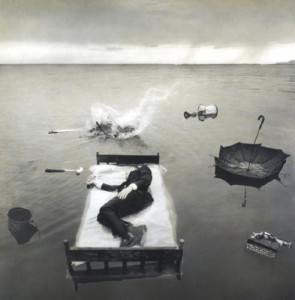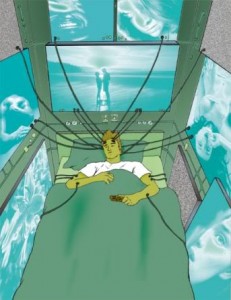A lucid dream is one in which the dreamer is aware of being in a dream state while the dream is still in progress. Lucid dreams can be extremely vivid and realistic, depending on the level of self-awareness during the dream. Most strikingly, lucid dreamers report being able to actively participate in and often manipulate experiences within the dream environment — that is, deliberately walk, fly, look around, handle objects, and interact with dream persons.
 |
Lucid dreams provide a unique opportunity to find out more about the experience of dreaming — and, by extension, perhaps more about the experiences of shamans, and about other visionary experiences, including those related to ayahuasca.
It is clear, however, that dream reports, given after the dreamer awakens, have a number of methodological problems — problems with recall, conflation, censoring, exaggeration, and confabulation. Dream states are notoriously slippery and prone to being forgotten. Significant details are easily either lost or filled in; coherence is imposed on narrative; connections drawn later are understood as part of the dream itself; memory of the dream is subject to constant revision. People may fail to report the contents of dreams that they perceive to be too revealing, embarrassing, or in conflict with the dreamer’s waking persona.
Here is a simple example. Can a lucid dreamer perform mathematical calculations during a dream? If a lucid dreamer is instructed beforehand to calculate, say, the factors of sixteen while in a lucid dream, will the dreamer be able to do it? And — here is the methodological question — how would we know? The dreamer may misreport or misremember the dream content; the dreamer may dream that he or she had calculated the factors of sixteen without actually having done so.
What we would like, of course, is for the dreamer to answer the question during the dream, and somehow communicate that answer to the investigator.
Similarly, some lucid dreamers report being able to control events in their dreams. There is some reason to believe there are limits to this control — for example, that major changes in dream setting, or even sudden changes in ambient light, such as turning on or off a light switch, are beyond the power of a lucid dreamer. Interestingly, lucid dreamers almost universally are unable to read material of any complexity, being able to read only a few words, with longer sequences deteriorating quickly into gibberish. Again, we would like to have the dreamer both carry out and report the results of reading experiments while still dreaming.
So: Is there any way for a lucid dreamer to communicate with us while dreaming? The problem is that, during REM sleep, when lucid dreams seem most likely to occur, there is physical paralysis — known as REM atonia — and difficulty of arousal. However, we can take a look at several interesting possibilities.
Here we can distinguish between passive communication from the dreamer to the investigator, using such tools as electroencephalography, and active communication, in which the dreamer voluntarily initiates and controls the communication.
It is possible to use instrumentation to attempt to confirm at least some claims of experiences in lucid dreams. In one case, a female lucid dreamer claimed to be able voluntarily to initiate sexual activity in her lucid dreams, leading to orgasms of “profound” intensity. She was fitted with EEG, EOG, and chin-EMG measuring devices, as well as devices to measure respiration, heart rate, vaginal EMG, and vaginal pulse amplitude. She was able to signal, with eye movements, when she was initiating dream sexual activity, and reported upon awakening that she had had an orgasm while dreaming.
 |
The instrumentation revealed that, at that time, her heart rate showed a moderate increase, and her respiration, vaginal blood flow, and vaginal muscle activity reached their highest point of the night. As a methodological issue, it is not clear whether — or by what criteria — those results count as a confirmation of an orgasm. It is reported that “comparable results were obtained with a male subject,” although presumably, in that instance, such elaborate instrumentation would be unnecessary, as would also concern over definitions.
This example raises important issues. To the extent that we are dealing with physiological correlates of internal states, when can it be said that instrumental verification of a physiological correlate confirms the reported state? Presumably what we would want to know about the female subject in the preceding paragraph is the state of her vaginal blood flow and muscle activity during a waking orgasm. Similar examples might include fear, excitement, sorrow, exaltation; to what extent can we claim to have confirmed such reports through physiological correlation? Can we legitimately generalize from physiological correlation of heart rate and fear, say, in waking life to a similar correlation in the course of a lucid dream?
The male volunteer raises similar questions. Since erections are regular concomitants of REM dream states in any event, to what extent does an erection confirm a report of voluntarily initiated sexual activity in a lucid dream? The question is generalizable, and once again raises the issue of baseline for particular dreamers.
But there are also ways in which the dreamer can voluntarily communicate while in the dream state. The most frequently used mechanism for voluntary communication from a dreamer is by eye movement. It appears that, when a lucid dreamer looks left or right in the dream, the physical eyes in fact make the corresponding motions, which can be picked up and measured by electrodes near the eye muscles. A number of ingenious experiments have been performed using these eye movements. Using such signals, experimenters can determine at what part of the sleep cycle lucid dreaming takes place, how long lucidity lasts, and the correlation of lucid dreams with REM and NREM sleep. Moreover, it has been possible to show that lucid dreamers can in fact remember tasks set for them before going to sleep and can carry out those tasks during the dream state.
For example, one lucid dreamer was instructed to draw triangles during the dream and follow the movement of his hands visually while doing so; and, indeed, the physical motions of his eyes while asleep corresponded to those that would have appeared had he been drawing a triangle while awake. Finally, eye movement has been used to show that a lucid dreamer’s sense of time is similar to his or her waking sense of time; instructed to signal with eye movements every ten seconds, lucid dreamers were about as accurate as their waking counterparts.
But eye signaling raises methodological issues of its own. While eye movement can signal that the dreamer is, in fact, lucid, it is difficult to use for more sophisticated communication. Moving the eyes apparently changes what the dreamer sees, and such changes in visual imagery apparently can on occasion be sufficiently disruptive to wake the dreamer. Further, there is a limit to the complexity of eye movement that can either be controlled by the dreamer or picked up by a polygraph, and, therefore, there seems to be a limit to the amount of information that can be transmitted by eye movement. Eye movement signaling is an information channel of very narrow bandwidth, usually confined, in experiments so far, to providing yes-no information.
 |
In addition to eye movements, it is at least on occasion possible that nerve impulses generated by voluntarily walking during a lucid dream can be detected by electrodes placed at the feet. Apparently a lucid dreamer, when moving his or her legs in a dream, can actually cause nerve impulses to travel down the legs; although the legs do not actually move, these impulses can be detected. It is not clear that this can be done consistently, or to what extent this ability is found among lucid dreamers generally. It has also been reported that a lucid dreamer can affect the rate of breathing in the physical body by changing the rate of breathing during the dream.
The possibilities of such communication can be multiplied by the utilization of various current heads-up and virtual reality devices. For example, it is possible to detect, with relatively accessible technology, not only the movement but the position of the eyes; there are digital cameras available that use this technology to focus on what the viewer is looking at. Data-glove technology, used in virtual reality simulations, can similarly detect minute changes in the positions of the fingers. It should be possible, with proper training, to develop more elaborate codes than the simple yes-no eye-movement codes previously used in lucid dreaming experiments.
Such studies apparently remain to be performed.

- Previous Post: Clean Water
- Next Post: A New Ayahuasca Book
- More Articles Related to: Shamanism



A really interesting post, with an angle that seems new and promising to dream research.
I've worked quite a bit with dreaming herbs, such as Silene from Africa and Calea from Mexico, and I've found that what they offer is greater lucidity in the dream, along with a connection between that realm and waking life that can be quite strong throughout the next day. We've been talking about this on our site, part of a collaborative dreaming project that we're doing, here's some background on that:
http://al-kemi.com/alchemy/tag/dreaming/
This has been a very fruitful path for me, and I think Calea relates very much to the post here, as it will bounce you in and out of dreaming lucidity, in and out of sleep, and even seemingly out of dreaming to a waking state that turns out to be another dream.
It would be really interesting to combine the help that the dreaming plants can give with the scientific methods in this post, maybe along with some communication-aid herbs, to get wisdom from the dream while still in it.
Strength & Wisdom,
Micah
http://www.al-kemi.com
Thank you for your comment and the link to your fascinating shop and dream project. I agree that a lot more research is needed into dream states of all sorts, including the oneirogenic plants. I have also written a little bit about dream interpretation here, and I would be most interested in your thoughts. I am delighted to be in touch with you.
Steve – I once knew a guy named George Gillespie well. For his very lucid work on lucid dreaming, see: http://dreamtalk.hypermart.net/member/files/george_gillespie.html
For awhile he was actually a grad student in Sanskrit at Penn, but a former Baptist minister (decisively non-evangelical) who lived for more than 20 years in Assam, NE India, known for very curious phenomena. We visited a number of Tibetan temples in New Jersey in about 1986 and spoke with the resident monks there about lucid dreaming. George’s work on lucid dreaming is quite amazing – he has developed workable spiritual practices from that state. He does not speak of dreaming herbs or shamanism, but his work is valuable.
As always, I am grateful for your most interesting comment. I have taken a quick look at the link you provided, and even glanced at some of the articles Gillespie has written. [sigh] I can see how I am going to spend the afternoon.
Some weeks ago during a major life crisis, at age 57, I suddenly found myself applying the test of lucidity to a particularly pleasant dream in which I had somehow got all the real-life problems ‘sorted’ for just a few moments. I thought ‘prove it’s a lucid dream by doing the impossible’. As I instantly floated up to the ceiling I jumped right into the pilot’s scene for what was subjectively about 12 minutes of flying. I was through many amazing landscapes, surreal constructions and cities while rehabilitating and enjoying the many fantastic flying skills I’ve slowly been learning over the years, such as where I swoop a mile at rooftop or treetop, then drop to my feet next to a pedestrian. Yeah, sure, I like showing off but what’s wrong with that? If one of the other people in the dream wanted to fly too, it wouldn’t phase me. I also like Hovering just a matter of inches off the ground but moving from point to point at this height incredibly fast. I enjoy that enlightening realisation that I don’t need to understand HOW I’m doing what I’m doing or getting away with it, all I need do is appreciate and USE the abilities!
I began semi-consciously selecting the scenery and architectural opportunities for myself to explore, like an acid trip where whatever you wish for materialises (?)
Anyway after a magnificent flying display through some enormous ancient ghost town in the rocky desert, utilising the magnificent setting-sun lighting, I turned round and swooped back to look at a mature plump woman who seemed to be giving me non-verbal but extremely obvious personal signals of sexual seduction. I plopped to a stop in my velvet slippers and asked her straight out if she was up for a good shagging – there’s no such thing as Sexual Offenders Register in MY dream. She smiled a yes and, even tough I could have enjoyed going on with the flying tour for ages I turned to get the warm pumping physical thrills I’ve been missing for years. You guessed it – sudden overnight ‘wee-wee’ signal and the dream was over.
After the toilet I quickly reviewed how much I could remember of the dream. Four very vivid landscapes, an ernormous hundred-story hotel and shooping complex where I could indulge my voyeur/exhibitionist fantasies for hours – hey, in my dream, I AM the only Police Force we need, believe it!
I managed to dive back in to some degree, but the dream wasn’t lucid after that point.
I learned lots about lucid dreaming while I was in Oxford 1988-1990, thanks to the Institute for Para-Normal REsearch (or somesuch) on Banbury Road, which I encountered while making my way through a sheet of LSD and some impeccable resin. Like the Count himself, I took to going to sleep with pen and pad right next to me to capture details on my waking.
Funnily enough, I came to your Blog through some cool comedy video on YouTube but while reading I had a feeling of ‘flashback’ to the lucid dream.
Anyway Steve, now I’ve seen your picture and see it’s like one of my own favorite incarnations (Professor Wu)I’ll certainly shout ‘Hi!’ whenever I see you in a dream. Can’t offer you any drugs but I’ll be happy to pay for any you want to share!
I envy your truly wonderful lucid dream. I sometimes get to fly, fairly fast, at my usual eye level; I can control what direction I go in, but I am constantly surprised by the changing landscape. Perhaps I will get to visit your shopping complex. :-)
I have some more posts about dreams here and here. I would be interested in your thoughts.
Interesting writings about Lucid Dreaming!
Maybe you like my (free) audio-course on Lucid Dreaming at http://www.balancingtools.com/luciddreaming